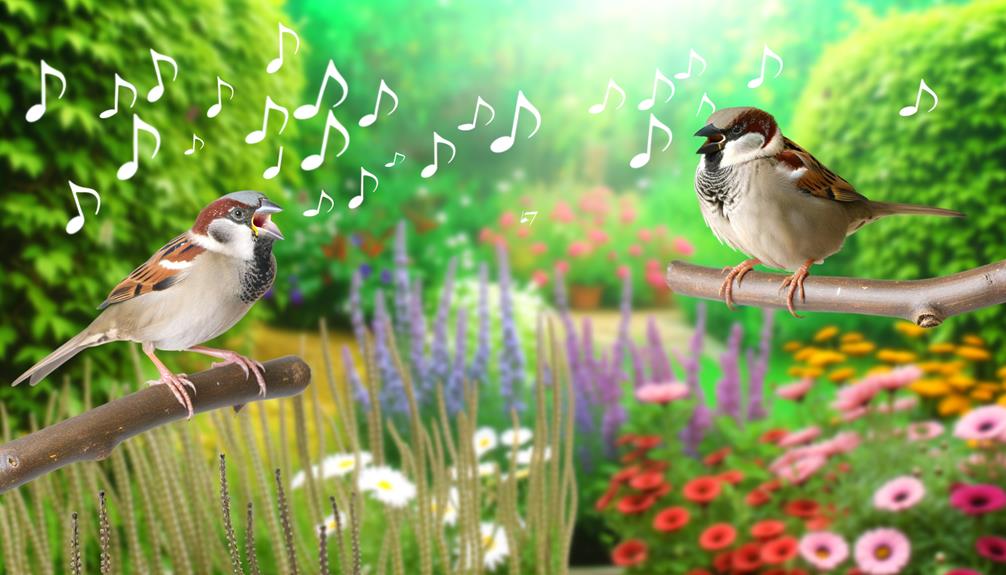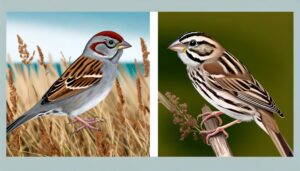10 Key Differences: House Vs Tree Sparrow
House sparrows and tree sparrows have unique distinctions. House sparrows sport a gray crown and black bib; tree sparrows have a chestnut crown and white cheeks.
Habitat preferences differ: house sparrows thrive in urban environments, while tree sparrows favor rural woodlands and farmland. Regarding diet, house sparrows mainly eat grains and seeds, while tree sparrows consume a broader range, including insects.
Nesting behavior also varies, with house sparrows using man-made structures and tree sparrows opting for tree cavities. Their vocalizations and social structures differ significantly, impacting their interactions and conservation needs.
There's much more to discover about these fascinating birds.

Key Takeaways
- House sparrows have a gray crown and black bib, while tree sparrows have a chestnut crown and white cheeks.
- House sparrows prefer urban environments; tree sparrows favor rural and woodland habitats.
- House sparrows primarily eat grains and seeds; tree sparrows have a more diverse diet including insects.
- House sparrows nest in man-made structures, whereas tree sparrows use natural tree cavities.
- House sparrows' songs are monotonous chirps, while tree sparrows' songs include melodic trills and whistles.
Physical Characteristics

House sparrows and tree sparrows frequently exhibit distinct physical characteristics that aid in their identification. House sparrows (Passer domesticus) display a robust build with males showing a distinctive gray crown, black bib, and chestnut nape. Females, however, have a more subdued brown and beige coloration.
Conversely, tree sparrows (Passer montanus) are smaller, with a rich chestnut crown, white cheeks accented by a black spot, and dual white wing bars on both sexes. Their smaller size and more defined head markings set them apart from house sparrows. The bill color also varies seasonally; house sparrows' bills turn black during the breeding season, while tree sparrows retain a more consistent grayish hue.
These physical traits are essential for ornithologists and bird enthusiasts in distinguishing between the two species.
Habitat Preferences
In addition to their distinct physical characteristics, house sparrows and tree sparrows also exhibit notable differences in their habitat preferences. House sparrows thrive in urban and suburban environments, often nesting in buildings, eaves, and other human-made structures. They're highly adaptable and can live in close proximity to humans.
In contrast, tree sparrows prefer rural settings, favoring open woodlands, hedgerows, and farmland. They're less tolerant of urban areas and typically nest in tree cavities or nest boxes. These habitat choices reflect their differing needs for shelter, nesting sites, and protection from predators.
Understanding their habitat preferences is essential for conservation efforts, as it informs strategies tailored to each species' specific environmental requirements.
Feeding Habits

Often exhibiting distinct dietary preferences, the feeding habits of house sparrows and tree sparrows reveal significant differences in their ecological niches. House sparrows primarily consume grains and seeds, often relying on human-provided food sources. In contrast, tree sparrows exhibit a broader diet that includes seeds, insects, and other small invertebrates. This dietary flexibility allows tree sparrows to thrive in more varied environments.
| Aspect | House Sparrow | Tree Sparrow |
|---|---|---|
| Primary Diet | Grains and seeds | Seeds, insects, invertebrates |
| Dependency | High on human sources | Lower, more self-sufficient |
| Feeding Grounds | Urban and suburban | Rural and woodland |
| Seasonal Changes | Minimal | Moderate |
| Foraging Behavior | Ground feeders | Bushes, trees, ground |
These differences underscore their adaptability and influence their respective roles within ecosystems.
Nesting Behavior
House and tree sparrows exhibit distinct nesting behaviors. House sparrows often choose urban environments and utilize man-made structures for nesting. In contrast, tree sparrows prefer natural sites such as tree cavities.
Both species gather a variety of materials for nest construction, including grass, feathers, and twigs. However, they differ in their approach to parental care. House sparrows tend to show more communal nesting tendencies.
Preferred Nesting Locations
Tree sparrows typically select natural cavities in trees for their nests, while house sparrows prefer urban structures like buildings and bridges. This choice reflects their adaptability to different environments.
Tree sparrows often inhabit rural and forested areas, making use of tree hollows and dense foliage. They favor locations that provide natural cover and protection from predators.
House sparrows, conversely, thrive in urban and suburban settings. They exploit man-made structures, finding crevices in buildings, under eaves, and within bridges. Their nesting behavior underscores their symbiotic relationship with human development.
Despite their differing habitats, both species demonstrate a strong preference for sheltered, secure nesting sites that offer safety for their offspring. This nesting behavior ensures their survival and reproductive success in varied environments.
Nest Construction Materials
In their nest construction, tree sparrows primarily use natural materials like twigs, grass, and feathers, while house sparrows incorporate a mix of natural and human-made items such as paper, string, and plastic.
Tree sparrows meticulously gather twigs and weave them into a sturdy structure, lining the interior with soft grass and feathers for insulation. In contrast, house sparrows exhibit adaptive behavior by utilizing available urban materials. They collect paper scraps, bits of string, and even plastic, integrating these into their nests alongside traditional natural elements.
This eclectic approach not only reflects their adaptability but also highlights the influence of human activity on avian nesting practices. Both species demonstrate remarkable resourcefulness in selecting materials that guarantee the structural integrity and comfort of their nests.
Parental Care Strategies
Parental care strategies differ significantly between tree sparrows and house sparrows, reflecting their unique adaptations to their respective environments. Tree sparrows typically nest in natural cavities or dense foliage, providing a concealed environment for their offspring. House sparrows, on the other hand, often choose human-made structures, benefiting from the proximity to food sources.
Tree sparrows:
- Both parents share feeding duties, ensuring balanced nutrition.
- Engage in rigorous nest sanitation, removing fecal sacs to keep the nest clean.
House sparrows:
- Males often assume a protective role, guarding the nest from predators.
These strategies illustrate each species' evolutionary responses to their habitats, optimizing offspring survival in differing ecological niches.
Vocalizations

House sparrows and tree sparrows exhibit distinct vocalization patterns that serve different communication purposes. Researchers have observed variations in their song patterns and call frequencies, which are essential for territory defense, mating, and social interactions.
This section will examine these differences in detail, providing insights into their communication strategies.
Song Patterns Comparison
Both the house sparrow and tree sparrow exhibit distinct vocalization patterns that serve as key identifiers for species recognition and communication. The house sparrow's song comprises a series of monotonous chirps, often repeated in rapid succession. In contrast, the tree sparrow's song is more melodic, incorporating a variety of trills and whistles. These differences are essential for:
- Attracting mates and establishing territory
- Distinguishing between members of their own species and others
- Facilitating social cohesion within flocks
House sparrows tend to vocalize more frequently in urban environments, reflecting their adaptability to human presence. Tree sparrows, however, favor rural and woodland areas, where their more complex songs resonate through quieter habitats. This divergence in song patterns underscores their ecological preferences and adaptive strategies.
Call Frequency Differences
While song patterns provide insight into species-specific communication, call frequency differences offer another dimension to understanding their vocal behaviors. House sparrows and tree sparrows exhibit distinct call frequencies, which can be measured in Hertz (Hz). On average, house sparrow calls range between 2,500 to 4,500 Hz, whereas tree sparrow calls span from 3,000 to 5,000 Hz. These frequency ranges reflect their adaptation to different environments.
| Feature | House Sparrow (Hz) | Tree Sparrow (Hz) |
|---|---|---|
| Minimum Frequency | 2,500 | 3,000 |
| Maximum Frequency | 4,500 | 5,000 |
| Typical Call Range | 3,000 – 4,000 | 3,500 – 4,500 |
| Peak Frequency | 3,500 | 4,000 |
| Environmental Adaptation | Urban | Rural |
Communication Purposes Analysis
Analyzing the vocalizations of sparrows reveals that their calls serve various communication purposes, ranging from attracting mates to signaling alarm. House Sparrows and Tree Sparrows use distinct vocal patterns to convey different messages. House Sparrows often emit a series of chirps to establish territory and court mates. Tree Sparrows, in contrast, produce a more complex array of calls.
- Soft chips: Indicate contentment or social bonding.
- Sharp alarm calls: Warn of predators.
- Melodic songs: Used mainly during mating season.
These vocalizations are crucial for their survival and reproductive success.
Social Structure
House sparrows and tree sparrows exhibit distinct social structures, each adapted to their specific environmental contexts and survival strategies. House sparrows form large, loose colonies often centered around human habitation. Their social organization benefits from collective vigilance and shared resources, enhancing their survival in urban and suburban environments.
Conversely, tree sparrows display a more territorial social structure. Pairs or small groups defend their nesting sites within wooded areas or hedgerows. This territorial behavior minimizes competition for food and nesting sites, ensuring better reproductive success.
Both species exhibit a degree of social flexibility, adjusting their behaviors based on environmental pressures and resource availability. Understanding these social structures reveals their adaptive strategies, highlighting their resilience and ecological significance.
Conservation Status

Both house sparrows and tree sparrows face varying degrees of conservation concern due to habitat loss, environmental changes, and other anthropogenic factors. House sparrows have seen a sharp decline in urban areas, attributed to reduced nesting sites and food sources. In contrast, tree sparrows are more sensitive to agricultural practices, with intensive farming reducing their habitats.
Key threats include:
- Urbanization: Diminishing green spaces and old buildings.
- Agricultural Intensification: Monoculture crops and pesticide use.
- Climate Change: Altered migration patterns and food availability.
Conservation efforts focus on habitat restoration and monitoring population trends. By addressing these issues, both sparrow species can be safeguarded, ensuring their continued presence in diverse ecosystems.
The necessity for such measures underscores the critical intersection of environmental health and biodiversity.
Conclusion
In the grand battle of House Sparrow vs. Tree Sparrow, it's clear both contestants bring their A-game.
While the House Sparrow flaunts its urban prowess and dumpster-diving skills, the Tree Sparrow prefers a more bucolic lifestyle, sticking to rural retreats.
Both species, despite their differences, share a common knack for surviving humanity's chaotic world.
So, whether they're squabbling over crumbs or serenading their mates, these sparrows prove that adaptability is truly for the birds.






